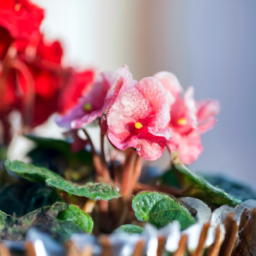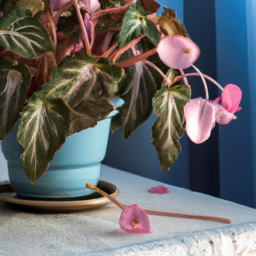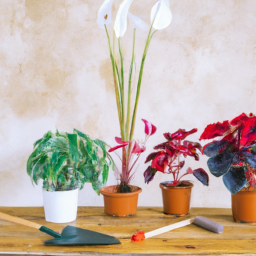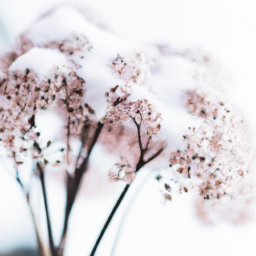
Hey there, plant enthusiasts! Are you tired of waiting for spring to see beautiful blooms in your home? Well, we’ve got some good news for you. In this blog post, we’re going to dive into the wonderful world of year-round blooms with indoor flowering plants. Yes, you read that right – you can enjoy vibrant and colorful flowers all year long, right in the comfort of your own home. Whether you have a green thumb or are a beginner in the world of gardening, we’ve got you covered. So, let’s get started and discover the secrets of creating an indoor oasis filled with stunning blossoms that will brighten up any space, no matter the season.
Benefits of Indoor Flowering Plants: Enhancing Your Living Space
Indoor flowering plants not only add beauty and charm to your living space but also offer numerous benefits that can greatly enhance your overall well-being. Whether you have a green thumb or are a beginner in the world of gardening, incorporating these delightful plants into your home can bring a sense of joy and tranquility. Let’s explore the various advantages of having indoor flowering plants and how they can transform your living space into a vibrant oasis.
1. Improving Air Quality
One of the most significant benefits of indoor flowering plants is their ability to purify the air in your home. Plants naturally absorb carbon dioxide and release oxygen through a process called photosynthesis. However, certain flowering plants, such as peace lilies, spider plants, and gerbera daisies, go a step further by actively filtering harmful toxins from the air, including formaldehyde, benzene, and trichloroethylene.
These toxins are commonly found in household items like carpets, furniture, and cleaning products, and their presence can lead to various health issues such as headaches, respiratory problems, and allergies. By introducing indoor flowering plants into your living space, you can significantly reduce the concentration of these pollutants, creating a healthier environment for you and your loved ones.
Furthermore, the increased humidity levels around indoor plants can help alleviate dry skin, sore throats, and respiratory discomfort caused by dry indoor air. This natural humidification effect can be particularly beneficial during the winter months when central heating systems tend to dry out the air in our homes.
2. Boosting Mood and Reducing Stress
Indoor flowering plants have been proven to have a positive impact on our mental well-being. The vibrant colors and soothing fragrances of blooming flowers can instantly uplift our mood and create a calming atmosphere. Whether it’s a colorful orchid, a delicate rose, or a cheerful daisy, the presence of these blossoms can evoke feelings of happiness, relaxation, and serenity.
Studies have shown that being surrounded by nature, even in the form of indoor plants, can help reduce stress levels and improve overall mental health. The act of caring for plants and watching them grow can also provide a sense of purpose and fulfillment, promoting a greater sense of well-being and satisfaction in our daily lives.
In addition, indoor flowering plants can enhance productivity and concentration. Research has indicated that having plants in the office or study area can improve focus, creativity, and problem-solving abilities. So, whether you’re working from home or studying for an important exam, having a few indoor flowering plants nearby can create a more conducive environment for success.
3. Creating a Visual Oasis
Indoor flowering plants offer an endless array of colors, shapes, and textures, allowing you to create a visually stunning oasis within your living space. From the vibrant petals of orchids to the delicate foliage of ferns, there is a flowering plant to suit every taste and style.
You can use indoor flowering plants to add pops of color to neutral-toned rooms or create a lush, tropical ambiance with large leafy plants. Hanging baskets overflowing with cascading flowers can bring a touch of whimsy to any corner, while tall flowering plants can act as striking focal points in larger spaces.
Furthermore, indoor flowering plants can be arranged in various ways to complement your existing decor. Whether you prefer a minimalist approach with a single statement plant or a lush jungle-like display of multiple species, the possibilities are endless. Experiment with different combinations and arrangements to create a personalized visual oasis that reflects your unique style and taste.
In conclusion, incorporating indoor flowering plants into your living space not only adds beauty and charm but also provides a myriad of benefits for your overall well-being. From improving air quality and reducing stress to creating a visually appealing oasis, these plants have the power to transform your home into a vibrant and tranquil sanctuary. So, why wait? Start exploring the world of indoor flowering plants and embark on a journey of natural beauty and serenity.

Year-Round Blooms: Indoor Flowering Plants
2. Popular Varieties of Year-Round Blooming Plants for Indoor Gardens
Welcome to the world of year-round blooms! Indoor flowering plants not only add beauty and vibrancy to your home but also provide a sense of tranquility and connection with nature. In this guide, we will explore some of the most popular varieties of year-round blooming plants that are perfect for indoor gardens. Whether you are a seasoned plant enthusiast or just starting your green journey, these plants will surely captivate your senses and bring joy to your space.
1. Orchids
Orchids are renowned for their exquisite beauty and elegance. With their stunning flowers and a wide range of colors, they make a perfect choice for indoor gardens. Orchids come in various species, each with its unique characteristics and blooming patterns. Some popular orchid varieties include Phalaenopsis, Cattleya, Dendrobium, and Oncidium.
When it comes to caring for orchids, it’s essential to provide them with the right conditions. They thrive in bright, indirect light and prefer a humid environment. Orchids should be watered regularly but avoid overwatering as it can lead to root rot. Additionally, fertilizing them with a balanced orchid fertilizer can help promote healthy growth and abundant blooms.
With proper care, orchids can bloom year-round, delighting you with their graceful flowers and adding a touch of sophistication to your indoor garden.
2. African Violets
African violets are beloved for their dainty, velvety flowers and compact size, making them ideal for indoor gardening. These charming plants come in a variety of colors, including shades of purple, pink, and white. African violets are relatively low-maintenance and can bloom continuously throughout the year when provided with the right care.
To ensure healthy growth and abundant blooms, African violets require bright, indirect light. Placing them near a north or east-facing window is usually ideal. They prefer well-draining soil and should be watered from the bottom to avoid wetting their leaves, which can cause damage. Fertilize African violets with a balanced, water-soluble fertilizer specifically formulated for these plants to promote blooming.
With their delicate flowers and compact habit, African violets are sure to bring a touch of charm and color to your indoor garden all year long.
3. Peace Lilies
Peace lilies are not only beautiful but also known for their air-purifying qualities, making them a popular choice for indoor gardens. These elegant plants feature glossy, dark green leaves and striking white flowers. Peace lilies are relatively easy to care for and can bloom multiple times a year.
When it comes to light requirements, peace lilies prefer bright, indirect light but can tolerate lower light conditions. However, avoid placing them in direct sunlight as it can scorch their leaves. Water peace lilies when the top inch of soil feels dry, and be cautious not to overwater them as it can lead to root rot. These plants thrive in slightly humid environments, so misting their leaves occasionally can be beneficial.
Fertilize peace lilies every few months with a balanced, water-soluble houseplant fertilizer to provide them with essential nutrients for healthy growth and continuous blooming.
With their stunning white flowers and air-purifying qualities, peace lilies are a fantastic addition to any indoor garden, creating a serene and tranquil atmosphere.
Now that you are familiar with some popular varieties of year-round blooming plants for indoor gardens, you can choose the ones that resonate with your style and preferences. Remember to provide them with the right conditions, including proper lighting, watering, and fertilizing, to ensure their optimal growth and abundant blooms. Enjoy the beauty and serenity these indoor flowering plants bring to your home throughout the year!

Tips for Caring and Maintaining Indoor Flowering Plants for Continuous Blooms
Welcome to the wonderful world of indoor flowering plants! If you’re looking to add a touch of natural beauty to your home year-round, you’ve come to the right place. In this guide, we will provide you with expert tips on how to care for and maintain indoor flowering plants to ensure continuous blooms that will brighten up your space.
Choosing the Right Indoor Flowering Plants
Before diving into the care and maintenance tips, it’s important to select the right indoor flowering plants that are suitable for your home environment. Different plants have different light and temperature requirements, so it’s crucial to choose plants that will thrive in your specific conditions.
1. Assess the lighting conditions in your home: Determine whether your space receives direct sunlight, indirect sunlight, or low light. This will help you select plants that can adapt to the available light.
2. Consider the temperature and humidity levels: Some flowering plants prefer warmer temperatures, while others thrive in cooler environments. Additionally, humidity requirements may vary among different plant species. Take these factors into account when making your selection.
3. Research plant characteristics: Learn about the growth habits, water requirements, and potential pests or diseases associated with the plants you’re interested in. This will give you an idea of the level of care and attention each plant needs.
Proper Watering Techniques
Watering is a critical aspect of caring for indoor flowering plants. Improper watering can lead to root rot or dehydration, both of which can hinder continuous blooms. Here are some guidelines to follow:
1. Understand the water needs of your plants: Some plants prefer consistently moist soil, while others require periods of drying out between waterings. Research the specific watering requirements of your plants and adjust accordingly.
2. Use the right watering technique: Instead of pouring water directly onto the leaves, aim for the soil around the base of the plant. This helps prevent fungal diseases and allows the roots to absorb water more efficiently.
3. Avoid overwatering: Overwatering is one of the most common causes of plant problems. Ensure the pots have proper drainage holes, and only water when the top inch of soil feels dry to the touch.
Fertilizing for Healthy Growth
Fertilizing indoor flowering plants is essential for providing them with the necessary nutrients to support continuous blooms. Follow these tips for effective fertilization:
1. Choose the right fertilizer: Look for a balanced, water-soluble fertilizer specifically formulated for flowering plants. This type of fertilizer typically contains equal amounts of nitrogen, phosphorus, and potassium (N-P-K).
2. Follow the recommended dosage: Over-fertilizing can damage plants, so it’s important to follow the instructions provided on the fertilizer packaging. Generally, it’s best to apply fertilizer every 2-4 weeks during the growing season.
3. Be mindful of seasonal changes: Adjust your fertilizing routine based on the seasons. Plants tend to require less fertilizer during the dormant winter months and more during their active growth periods in spring and summer.
Regular Pruning and Maintenance
To keep your indoor flowering plants healthy and encourage continuous blooms, regular pruning and maintenance are necessary. Here’s what you need to know:
1. Remove dead or yellowing leaves: As plants age, some leaves may naturally decline. Remove them promptly to maintain the overall health and appearance of the plant.
2. Prune to promote new growth: Pruning stimulates growth and helps maintain the desired shape of your plants. Trim back leggy stems and pinch off spent flowers to encourage the development of new buds.
3. Monitor for pests and diseases: Keep a close eye on your plants for any signs of pests or diseases. Common indoor plant pests include aphids, spider mites, and mealybugs. If detected, take immediate action to prevent further damage.
Caring for indoor flowering plants requires patience and attention to detail, but the rewards are well worth it. By choosing the right plants, providing proper watering and fertilization, and regularly maintaining them through pruning and pest control, you can enjoy a continuous display of blooms that will bring beauty and joy to your indoor space throughout the year.
Here are the Essential Points
Are you tired of looking at dreary, bare corners of your home during the long winter months? Well, fear not! There’s a simple solution to bring some life and color into your living space all year round: indoor flowering plants. These beautiful plants not only add a touch of nature to your home but also provide a sense of tranquility and relaxation.
Indoor flowering plants are a great way to brighten up any room, regardless of the season. With a wide variety of options to choose from, you can easily find a plant that suits your style and preferences. From vibrant orchids to delicate peace lilies, there’s a flowering plant for every taste. These plants not only look stunning but also help purify the air by removing toxins and releasing oxygen. Plus, they can even boost your mood and reduce stress. So, why wait for spring to enjoy the beauty of blooming flowers when you can have them all year round?
Here are this week’s Top Questions and Answers
Q1: What are some indoor flowering plants that bloom year-round?
A1: There are several indoor flowering plants that can bloom year-round, adding beauty and color to your home throughout the seasons. Some popular options include:
- Peace Lily: Known for its elegant white flowers, the peace lily thrives in low light conditions and requires minimal care.
- African Violet: With its vibrant purple, pink, or white flowers, the African violet is a popular choice for indoor gardens.
- Orchids: These exotic flowers come in a variety of colors and can bloom for several months with proper care.
- Bromeliads: Known for their unique and vibrant blooms, bromeliads are easy to grow and can add a tropical touch to your indoor space.
- Kalanchoe: This succulent plant produces clusters of colorful flowers and is relatively low-maintenance.
Q2: How can I ensure year-round blooms from my indoor flowering plants?
A2: To ensure year-round blooms from your indoor flowering plants, it’s important to provide them with the right conditions and care:
- Light: Most flowering plants require bright, indirect light. Place them near a window where they can receive ample sunlight without being exposed to direct rays.
- Watering: Follow the specific watering instructions for each plant, as different species have different needs. Overwatering can lead to root rot, while underwatering can cause the plants to wither.
- Fertilization: Use a balanced, water-soluble fertilizer formulated for flowering plants to provide essential nutrients. Follow the recommended dosage and frequency.
- Temperature and Humidity: Maintain a suitable temperature range and humidity level for your plants. Most flowering plants prefer temperatures between 65-75°F (18-24°C) and moderate humidity.
- Pruning and Deadheading: Regularly remove dead or faded flowers to encourage new blooms. Pruning can also help shape the plants and promote healthy growth.
Q3: Can indoor flowering plants bloom throughout the year without natural sunlight?
A3: While most indoor flowering plants require some amount of natural sunlight to bloom, there are options for those without access to adequate sunlight:
Grow lights: You can use artificial grow lights specifically designed for plants. These lights mimic natural sunlight and provide the necessary spectrum of light for flowering plants to thrive.
LED grow lights are particularly popular as they are energy-efficient and emit less heat, reducing the risk of damaging the plants.
Q4: Are there any indoor flowering plants that are safe for pets?
A4: Yes, there are several indoor flowering plants that are safe for pets. Here are a few examples:
- Spider Plant: Known for its air-purifying qualities, spider plants are non-toxic to cats and dogs.
- Boston Fern: These lush ferns are safe for pets and add a touch of greenery to your indoor space.
- Phalaenopsis Orchids: While orchids are generally safe, the Phalaenopsis variety is non-toxic to pets.
- African Violet: These colorful flowers are pet-friendly and can be a delightful addition to your home.
However, it’s always a good idea to double-check the specific plant’s toxicity level before introducing it to your pet’s environment.
Q5: Can I grow indoor flowering plants in containers or pots?
A5: Absolutely! Indoor flowering plants can be grown in containers or pots, making them suitable for any indoor space. Here are a few tips:
- Choose the right size pot: Ensure the pot is large enough to accommodate the plant’s root system and allow for growth.
- Use well-draining soil: Opt for a high-quality potting mix that provides good drainage to prevent waterlogged roots.
- Consider the plant’s needs: Different plants have different soil and watering requirements. Research the specific needs of your chosen plant to ensure optimal growth.
- Provide proper drainage: Ensure the pots have drainage holes to prevent excess water accumulation, which can lead to root rot.
- Rotate the pots: Rotate the pots occasionally to ensure even exposure to light and prevent the plants from leaning towards a specific direction.
With the right care and suitable containers,

James Wong is a renowned ethnobotanist, plant scientist, and local television presenter. With a passion for demystifying plant science, he is known for translating complex botanical concepts into practical advice for everyday plant enthusiasts. James’s expertise spans from traditional gardening to cutting-edge plant technologies, making his insights accessible and informative.


